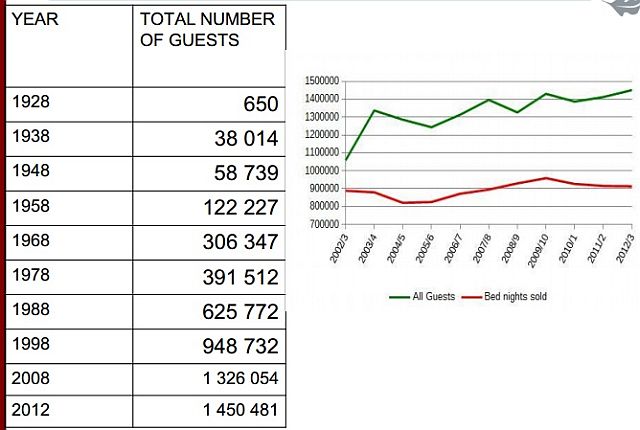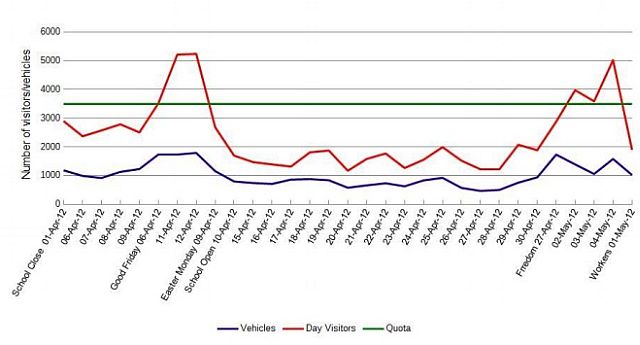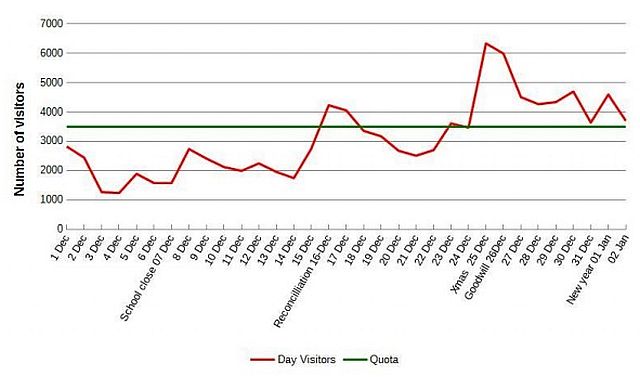Management of Congestions in the Kruger National Park
Posted: Sun Dec 14, 2014 4:00 pm
Kruger National Park: Tourism development and issues of social carrying capacity in the management of large numbers of tourists
Sanette Ferreira & Alet Harmse
Real world problem
Day visitor numbers have increased and congestion of tourist traffic over weekends and certain public holidays has intensified in the Marula south part of KNP with concomitant impacts on the wildlife-viewing experience
Wildlife experience on a public holiday in Marula-South, KNP
On the Sunday morning a family of about 70 elephants moved from the Sabi riverbank across the road and the subsequent ‘wildlife spectacle engrossed’…
Most of the other tourists who could not share in the scene and experience were visibly frustrated, having to sit in their cars under the African sun… and wait impatiently and annoyed for their unpleasant and prolonged experience to end.
Complaints voiced by tourists in the Marula-South area, KNP
~ Not enough staff at the reception area or gate
~ Waiting in queues despite having made reservations to enter the park
~ OSV vehicles blocking sightings, inconsideration of others and rude guides
~ Other visitors alighting from their vehicles
~ Litter along the roads, especially during peak season
~ Not enough ablutions – cannot accommodate winterseason pressures
~ Ablutions not cleaned timeously
~ Inappropriate behaviour of tourists at sightings
Source: KNP visitor feedback
Kruger road rage incident : February 2014
…a guide alighted from a safari-vehicle…and screamed at an elderly Couple…walk around the vehicle and open the door…
Overarching aim
To determine what has changed in tourism infrastructure and superstructure, and visitors’ management since 1997 vis-à-vis the large numbers of day visitors, the allocation of access (Wild Cards for local visitors) and the changes in the landscape matrix on the south-western border of KNP.
• Changes in management philosophy,
• The mechanisms for managing the TCC of the park
• The wildlife attraction value of the southern part (Marula-South) and the tourism developments adjacent to the park that contribute to tourist crowding.
Wildlife viewing experience
Visitors’ experiences and the degree of satisfaction provided by the experiences are crucial to deciding on appropriate management actions.
• Common trade-offs are likely to occur between:
- maintaining low visitor densities and providing ready access by the public to wildlife;
- between low disturbance levels to wildlife and close proximity between visitors and wildlife;
- and between providing a ‘natural’ and a strong ‘managerial footprint’ (Whittaker,Vaske & Manfredo, 2002; Higginbottom, 2004).
• Wildlife tourism should be planned and managed to maximise net benefits to society and other stakeholders as well as to prevent disturbance to wildlife (Manfredo & Driver, 2002; Newsome & Rodger, 2012).
Methodology
Secondary information:
Published and unpublished sources, including master plans on tourist policy, park zonation maps and semi-structured interviews.
Primary information:
• Popular tourist roads, waterholes and picnic spots were monitored during four different time windows in 2013 (mid-week days, weekends, public holidays and school holidays in JuneJuly).
• The number of vehicles and tourists entering the park at specific gates was obtained from the SANParks central database at the Pretoria headquarters.
• Semi-structured interviews were conducted with ten members of park management representing different sections inside and outside the park (development and planning, conservation, tourism operations, and tourism development marketing).
Interviewees
were asked about
• New infrastructural and super-structural developments
• Tourist traffic
• Tourist-vehicle collisions with wildlife
• Changes in visitor management-policies and changes over the last 14 years
• Scenarios on tourism development
• Challenges currently experienced
• How visitors expectations are met now and in the future
• External developments on the southern and south-western borders of the park
• congestion of tourists in the park on certain days in specific seasons

Day visitors to KNP

Capacity limits

Day visitors and vehicles to KNP during the Easter School holiday, Easter weekend and Freedom Day/Workers

Day visitors during the December school holiday and the Christmas weekend 2012


Most conflicts in carrying capacity do not solely revolve around resource questions, but involve value issues
• Tourist carrying capacity change when management objectives are altered or when user populations change radically (Manning, 2011).
• This has happened over the last 14 years in KNP. Whereas many of the new policies in South Africa promote the sustainable development of the nation's resources, political pressure compels KNP (and other national parks and recreation areas) to make the areas more available to broader segments of the population.
• The challenge is how to manage this larger number of tourists, especially day visitors to Marula-South, and whether park managers have the political will to adopt and apply formulated policy.
A step in the right direction is that the park forms part of the integrated development frameworks of the municipalities adjacent to the park.
• A three-kilometre buffer zone outside the park’s borders
• A beneficial symbiotic relationship is essential between the park and its neighbours
The mechanisms used by KNP to prevent overcrowding have in practice, been largely unsuccessful in Marula-South.
• Private OHVs not being considered part of the daily quota per gate suggest that financial priorities take precedence.
- Regarding African national parks, this emphasis on profitability is pivotal where tourism potential is in danger of being over-exploited (Henry, 1980; Gilbert, Penda & Frielet al., 1994).
• Given that road to vehicle ratios and daily quotas per gate have been adapted while the ‘channel system’ (the roads) for self-drive tourists have stayed almost the same confirm the pressures to accommodate more visitors and not to restrict access on ‘flooded weekends’.
- This had led to ‘a creeping incremental development of tourist facilities’ within the park, as well as ‘changing the profile of the visitor towards those more tolerant of intensive uses’ (Butler, 1996: 291).
Sanette Ferreira & Alet Harmse
Real world problem
Day visitor numbers have increased and congestion of tourist traffic over weekends and certain public holidays has intensified in the Marula south part of KNP with concomitant impacts on the wildlife-viewing experience
Wildlife experience on a public holiday in Marula-South, KNP
On the Sunday morning a family of about 70 elephants moved from the Sabi riverbank across the road and the subsequent ‘wildlife spectacle engrossed’…
Most of the other tourists who could not share in the scene and experience were visibly frustrated, having to sit in their cars under the African sun… and wait impatiently and annoyed for their unpleasant and prolonged experience to end.
Complaints voiced by tourists in the Marula-South area, KNP
~ Not enough staff at the reception area or gate
~ Waiting in queues despite having made reservations to enter the park
~ OSV vehicles blocking sightings, inconsideration of others and rude guides
~ Other visitors alighting from their vehicles
~ Litter along the roads, especially during peak season
~ Not enough ablutions – cannot accommodate winterseason pressures
~ Ablutions not cleaned timeously
~ Inappropriate behaviour of tourists at sightings
Source: KNP visitor feedback
Kruger road rage incident : February 2014
…a guide alighted from a safari-vehicle…and screamed at an elderly Couple…walk around the vehicle and open the door…
Overarching aim
To determine what has changed in tourism infrastructure and superstructure, and visitors’ management since 1997 vis-à-vis the large numbers of day visitors, the allocation of access (Wild Cards for local visitors) and the changes in the landscape matrix on the south-western border of KNP.
• Changes in management philosophy,
• The mechanisms for managing the TCC of the park
• The wildlife attraction value of the southern part (Marula-South) and the tourism developments adjacent to the park that contribute to tourist crowding.
Wildlife viewing experience
Visitors’ experiences and the degree of satisfaction provided by the experiences are crucial to deciding on appropriate management actions.
• Common trade-offs are likely to occur between:
- maintaining low visitor densities and providing ready access by the public to wildlife;
- between low disturbance levels to wildlife and close proximity between visitors and wildlife;
- and between providing a ‘natural’ and a strong ‘managerial footprint’ (Whittaker,Vaske & Manfredo, 2002; Higginbottom, 2004).
• Wildlife tourism should be planned and managed to maximise net benefits to society and other stakeholders as well as to prevent disturbance to wildlife (Manfredo & Driver, 2002; Newsome & Rodger, 2012).
Methodology
Secondary information:
Published and unpublished sources, including master plans on tourist policy, park zonation maps and semi-structured interviews.
Primary information:
• Popular tourist roads, waterholes and picnic spots were monitored during four different time windows in 2013 (mid-week days, weekends, public holidays and school holidays in JuneJuly).
• The number of vehicles and tourists entering the park at specific gates was obtained from the SANParks central database at the Pretoria headquarters.
• Semi-structured interviews were conducted with ten members of park management representing different sections inside and outside the park (development and planning, conservation, tourism operations, and tourism development marketing).
Interviewees
were asked about
• New infrastructural and super-structural developments
• Tourist traffic
• Tourist-vehicle collisions with wildlife
• Changes in visitor management-policies and changes over the last 14 years
• Scenarios on tourism development
• Challenges currently experienced
• How visitors expectations are met now and in the future
• External developments on the southern and south-western borders of the park
• congestion of tourists in the park on certain days in specific seasons

Day visitors to KNP

Capacity limits

Day visitors and vehicles to KNP during the Easter School holiday, Easter weekend and Freedom Day/Workers

Day visitors during the December school holiday and the Christmas weekend 2012


Most conflicts in carrying capacity do not solely revolve around resource questions, but involve value issues
• Tourist carrying capacity change when management objectives are altered or when user populations change radically (Manning, 2011).
• This has happened over the last 14 years in KNP. Whereas many of the new policies in South Africa promote the sustainable development of the nation's resources, political pressure compels KNP (and other national parks and recreation areas) to make the areas more available to broader segments of the population.
• The challenge is how to manage this larger number of tourists, especially day visitors to Marula-South, and whether park managers have the political will to adopt and apply formulated policy.
A step in the right direction is that the park forms part of the integrated development frameworks of the municipalities adjacent to the park.
• A three-kilometre buffer zone outside the park’s borders
• A beneficial symbiotic relationship is essential between the park and its neighbours
The mechanisms used by KNP to prevent overcrowding have in practice, been largely unsuccessful in Marula-South.
• Private OHVs not being considered part of the daily quota per gate suggest that financial priorities take precedence.
- Regarding African national parks, this emphasis on profitability is pivotal where tourism potential is in danger of being over-exploited (Henry, 1980; Gilbert, Penda & Frielet al., 1994).
• Given that road to vehicle ratios and daily quotas per gate have been adapted while the ‘channel system’ (the roads) for self-drive tourists have stayed almost the same confirm the pressures to accommodate more visitors and not to restrict access on ‘flooded weekends’.
- This had led to ‘a creeping incremental development of tourist facilities’ within the park, as well as ‘changing the profile of the visitor towards those more tolerant of intensive uses’ (Butler, 1996: 291).